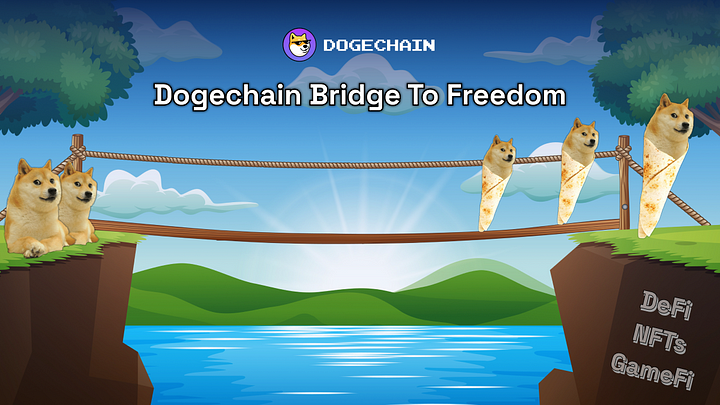When venturing into the Dogechain ecosystem, crypto users will frequently encounter the term “wrapped tokens”. Wrapped tokens are essential to DeFi as they enable seemingly incompatible blockchains to communicate and use each other’s token standards. Learning about these tokens will help you understand how Dogechain is able to provide Dogecoin with both smart contract capability and EVM compatibility.
Today, we will explain the notion of wrapped tokens and provide a list of their benefits and use cases. Moreover, we’ll explore some popular wrapped cryptos and how they work. We’ll also explain how wrapping Doge works on the Dogechain protocol. By the end of this post, you will be able to fully understand how wrapping Doge into the Dogechain smart contracts imbues it with added utility. Let’s get started, shall we?
What Are Wrapped Tokens?
Wrapped tokens are tokens that represent cryptocurrencies from another blockchain and whose value is pegged to the underlying crypto. Consequently, a wrapped token will always be worth the same as the crypto it’s representing.
During the wrapping process, the protocol sends the original asset into cold storage or a smart contract where it remains inaccessible. Simultaneously, the protocol mints a new token that can be used for transactions on other protocols.
When the user wishes to redeem their underlying cryptocurrency, the protocol destroys (burns) the wrapped tokens. After the burn, the protocol transmits the user’s initial assets from the smart contract/vault to their wallet. Thus, wrapped tokens are never simultaneously in circulation with the underlying asset they are pegged to.
In short, these tokens can be used on non-native blockchains that provide advanced DeFi features. They allow assets like Bitcoin (and now, Dogecoin) to be used on smart contract-capable blockchains and increase the utility of these isolated blockchain assets.
They also provide single-use case cryptocurrencies like Dogecoin with much-needed interoperability within a decentralized financial system. For instance, they open the door for lending, using Doge as collateral, liquidity mining, staking, and much more. Suddenly, a one-trick-pony like Dogecoin becomes a DeFi powerhouse, enabling users to access passive yields from their holdings.
Types of wrapped tokens
There are two main types of wrapped tokens:
- Redeemable tokens, which allow the users to reclaim their underlying asset in exchange for the wrapped token. Wrapped Dogecoin falls into this category.
- Cash-settled tokens, where the user cannot directly redeem its underlying token but receives compensation for it in another currency. This is the case for tokenized equities, commodities, art, etc.
Crypto users mostly encounter redeemable tokens, thanks to their inherent digital nature and fungibility.
How Does Wrapped Bitcoin Work?
Not surprisingly, the most popular wrapped token in existence is BTC. wBTC is an ERC-20 version of Bitcoin that allows investors to transpose their Bitcoin holdings directly into the Ethereum ecosystem. Since bitcoin is a proof-of-work blockchain that lacks smart contract capability, wBTC provides its holders with yield capabilities from popular DeFi platforms such as QuickSwap and Uniswap.
You can acquire wrapped Bitcoin through accredited merchants and custodians from the WBTC DAO. This process is relatively simple:
- Users send their Bitcoin to the merchant.
- The merchant then sends the BTC to an accredited custodian. This custodian then locks the coins in cold storage and mints wBTC at a ratio of 1:1.
- Finally, the merchant sends the wBTC to your ERC-20 wallet.
To retrieve the underlying BTC, the custodian will burn the wBTC and unlock an equal amount of coins before sending them to your wallet.
Why Do You Need to Wrap Ether?
While this sounds counterintuitive, wrapping Ether is a requirement for accessing the smart contract capabilities of its own blockchain. Unlike the tokens that run on its platform, ETH doesn’t comply with the ERC-20 token standards commonly used by DeFi platforms.
Fortunately, Ethereum wrapping is relatively straightforward and does not require custodians. Instead, crypto users rely on the Ethereum protocol to lock up ETH into a smart contract and mint the same amount of wETH. These wETH are ERC-20 tokens that enjoy all the standard’s advantages, including the ability e to be used on DEXes, lending platforms, NFT metaverses, etc.
When crypto users retrieve the underlying ETH, they call upon the smart contract to burn the wETH and release ETH to the user’s wallet.
Wrapped Dogecoin — How Does it Work?

Given all these capabilities, it’s hardly surprising to witness wrapped Dogecoin emerge on the Dogechain. Similar to Bitcoin, Doge is a PoW blockchain that lacks smart contracts. Consequently, Doge holders have no choice but to use the coin for its initial purpose — exchanging value online. This means no DeFi yields, no ability to mint NFTs, and above all, no interoperability with other blockchains.
Fortunately, Dogechain is built on the Polygon edge framework and enjoys EVM compatibility. Thus, wrapping Dogecoin on Dogechain will allow users to access the ever-growing ecosystem of Ethereum and Polygon dApps. In practical terms, this means that token holders will be able to plug their Doge into liquidity pools, lending protocols, NFT marketplaces, blockchain games… There are endless possibilities.
So how does wrapping DOGE on Dogechain work? Here’s what happens in a nutshell:
- Users bridge their DOGE on the Dogechain by sending the tokens into a cold wallet via a bridging app of the platform. They also provide the platform with a Dogechain ERC-20 address where they will receive their wrapped Doge.
- Since the cold storage wallet is a multisig wallet, three signers monitor the network for the arrival of new Dogecoin.
- Once the transaction has been confirmed by the wallet signers, they initiate a signature call to the Bridge Smart contract. The protocol mints wrapped Doge 1:1 and sends them to the user’s address.
When the user wishes to withdraw their underlying Doge, they simply need to transfer the wrapped Doge to the Bridge Contract. The protocol will then burn the wrapped tokens and send the equivalent amount of Doge to the user’s wallet address.
Benefits of Wrapped Doge

So what do you do with your wrapped Doge now that it sits in your wallet? Well, we previously mentioned how you can plug it into a wide range of DeFi protocols. This already unlocks an incredible set of features and use cases. But there’s more!
Staking wrapped Dogecoin on the Dogechain grants access to rewards in $DC tokens. In particular, the protocol will allocate 28.2% (282 billion $DC) of the total supply to users that stake their Doge on the Dogechain. Simply supporting the Dogechain network security will enable you to access APRs and add another income stream to your crypto portfolio.
Thus, wrapping Doge increases its utility, but also provides users with a steady stream of rewards to grow their holdings.
Wrapped-up Article
This article has hopefully answered your questions about wrapped tokens and how they work. You now realize how wrapping Doge exponentially increases its utility. Using Doge on the Dogechain provides financial versatility for our favorite meme coin and empowers the community by enabling it to participate in the ever-expanding DeFi ecosystem.
Join the family!
Website | Twitter | Telegram | Discord | Reddit | TikTok

